 Photo: Caleigh Waldman
Photo: Caleigh Waldman
Having an emergency kit in your car is a great idea for day-to-day driving, but it’s pretty much a necessity for long-distance road trips. That said, although buying a preassembled kit and being done with it is tempting, we haven’t found a great one yet after several hours of research. Even the most promising options suffer from jumper cables that are too short, too thin, or both. Basically, if you want a good kit, you’ll have to make it yourself, and we’re here to help.
We spent hours researching and testing each of these emergency essentials to ensure that they’ll be useful in case of an emergency, whether that’s your own or someone else’s.
On a desolate stretch of two-lane highway in northern Arizona, we were driving behind a rental camper van just as it had a rear tire blow out after hitting a rumble strip. The couple driving the van couldn’t find their jack, didn’t know where the spare tire was, and had come to a stop just past a low dip in the road. It wasn’t a good scene. But it couldn’t have happened at a better time (for them, at least). It gave us a great opportunity to put our emergency gear to the test!
Getting a membership to a roadside assistance program is also wise. We don’t have a single best recommendation for everyone, since your options and needs vary depending on what car you have, how you use it, and where you live, but here’s a good guide by Popular Mechanics on what to look for in choosing a plan. Basically, make sure your plan fits your needs. For example, if you live in a city, 3 miles of free towing might be enough. But if you’re going on a road trip across the desert, paying for more range is worthwhile.
Duct tape
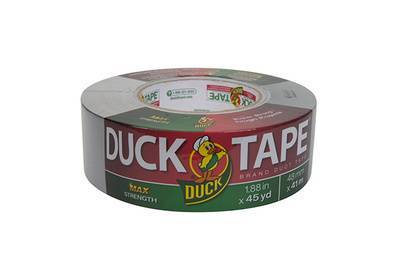
Super-strong and sticky, flexible enough to wrap around corners, and easy to tear in a clean, straight line.
If you can’t duct it, fuh-geddaboudit. We tested the hell out of 10 rolls of duct tape and chose Duck Max Strength duct tape above the competition for its perfect blend of attributes: high material strength, a strong adhesive, and superior overall flexibility for easy wrapping around odd shapes and curved surfaces. It also tears in a nice straight line and lends itself to short-term roadside repairs on your gear as well as on the interior and exterior of your car. It’ll even handle first aid duties when the right materials for the job are unavailable. Duct tape is, as any MacGyver fan will tell you, an indispensible tool.
However, if you’re driving a car that’s likely to need more long-term fixes than your average vehicle, our reviewer Doug Mahoney recommends picking up a roll of Sticky Ass Tape. “It’s the tape to grab,” he told us, “if you’re looking for a semi-permanent patch for the hole in your gutter or the rusted-out spot in the truck bed.” Sticky Ass didn’t have the raw strength of some of the other tapes we looked at, but after six weeks a strip of Sticky Ass left outside on a piece of plywood was still 100 percent adhered.
The trade-off for all of that extreme weather durability is handling issues. The 13-mil Sticky Ass is tough to tear, and once you’ve torn a piece off, it’s extremely difficult to rip again into two smaller pieces.
First aid kit
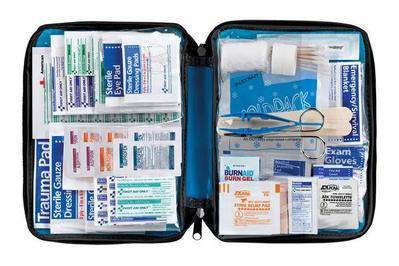
On the road, a first aid kit is useful for providing a way to keep someone comfortable until people with real medical expertise can help. It’s much more important to have a basic kit with you—along with the knowledge that none of the bandages have degraded and the disinfectants haven’t expired—than to have a 432-item, war-zone-worthy kit sitting at home.
We like the First Aid Only First Aid Essentials Kit. It lacks some of the higher-quality tools that we recommend for a wilderness first aid kit, but it comes with plenty of bandages, alcohol prep pads, pain relievers, and equipment to treat up to four people’s minor cuts and scrapes on a weekend trip. (For a full list and comparison chart, see our full guide.) —Eric Hansen
Tire gauge
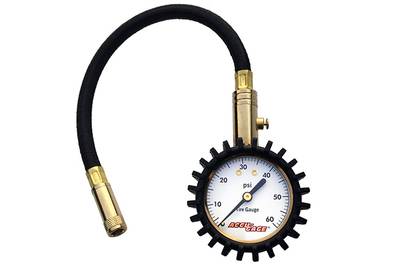
Checking your car’s tire pressure (including that of the spare tire) is like flossing: It’s something we all should do, but don’t. Proper inflation is vital—too much, and you’ll feel every bump and have more difficulty stopping your car. Too little, and your tires will wear faster. Worse, they’ll also overheat, which can separate treads and blow the tires, something we saw happen right in front of us in the middle of nowhere in Arizona. Don’t let that happen to you.
 Photo: Caleigh Waldman
Photo: Caleigh Waldman
When we asked three different San Francisco Bay Area tire shops which gauge they used, they all pointed to the Accu-Gage 60 PSI with shock protector. After our testing, which included road-tripping with the tool ourselves, the Accu-Gage has emerged as our favorite tire gauge for several years running. It’s accurate and durable, and unlike a digital gauge, it has no battery to wear out. The Accu-Gage is available in several different configurations, but the performance is largely the same. We prefer a version with a hose attached and a straight chuck because that design makes it easier to hold the gauge and check the tire pressure at the same time. The version we tested even comes with a removable rubber bumper in case you drop it.
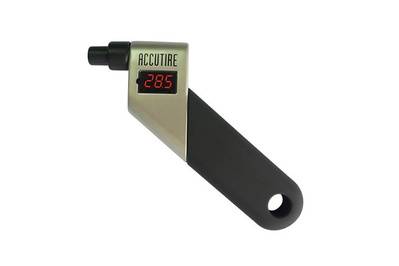
A digital display is more precise than analog, but the pros we interviewed all use analog gauges.
If you prefer digital, get the Accutire MS-4021B. The digital readout is easier to decipher than an analog dial (though it rounds to the nearest 0.5 psi), and the device is cheap, but you have to factor in the periodic cost of two watch batteries—according to owner reviews, they need replacing every six months. Other reviewers complain about its durability. Magazine reviewers say that digital gauges are more precise than analog dial gauges—often showing one or two decimal points—but the professional mechanics we talked to all use analogs. As one tire mechanic said of digital gauges, “They’re consistent, but consistently inaccurate, usually off by a full pound when compared to our gauges.” If you can tolerate reading an analog dial, we’d go with the Accu-Gage. —AG
Jumper cables
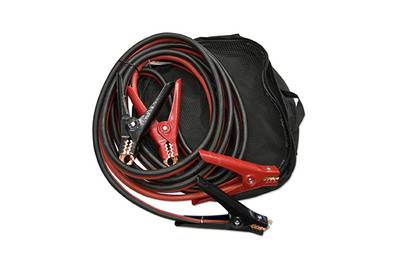
Every car trunk should have a good set of jumper cables. Accidentally leave an interior light on or the headlights engaged when you park, and you’ll come back to a dead battery. As such, you need a solid set of cables that are long enough for most scenarios and thick enough to carry sufficient current to jump most vehicles.
After scrutinizing the specs of dozens of options and having an electrical engineer analyze three top-rated models, we’d buy the AAA Heavy Duty 16-foot 6 Gauge Booster Cables. As this image illustrates, they’re long enough and thick enough for most situations, and their 400-amp current rating means they can handle most vehicles (even trucks and SUVs). They also come with a surprisingly sturdy and convenient mesh storage bag.
 Photo: Caleigh Waldman
Photo: Caleigh Waldman
One thing that sets the AAA cables apart from other cables we found on Amazon is that the 6-gauge description is accurate. For example, Capri sells a 4-gauge, 20-foot cable that reviewers say is closer to 8-gauge. That’s no good, because thinner cables can fail to deliver sufficient current to start trucks, SUVs, and other larger vehicles.
Bad clamps on jumper cables can be annoying, unsafe, or both, but the AAA clamps stand out as both well designed and well made. As you can see in the picture below, they have a little extended portion for clamping on increasingly common side-post batteries as well as standard SAE or JIS posts. The side opposite the extension meets flush and can clamp onto vertical posts if necessary. Compare that with the more expensive Coleman 4-gauge, 20-foot model, which does not close flush on the side opposite to the extension. And the clamps on the popular and otherwise heavy-duty cables from FJC have rounded tips that can make getting a good connection to the battery posts difficult.
 The AAA cables have excellent clamps that feature an elongated side for compatibility with a wider variety of battery terminals. Photo: John Neff
The AAA cables have excellent clamps that feature an elongated side for compatibility with a wider variety of battery terminals. Photo: John Neff
Build quality is also excellent, according to our electrical engineering consultant William Gardiner. After examining all the cables up close, Gardiner told us that the connection between wire and clamp appeared more secure on the AAA cables, while the 20-foot 4-gauge set from Wilmar were attached so tightly that the cables were pinched, causing some individual strands to slip out of the bracket holding them together.
 The connection point of the AAA cable (right) is more secure than that of the Wilmar (left). Photo: Michael Zhao
The connection point of the AAA cable (right) is more secure than that of the Wilmar (left). Photo: Michael Zhao
Some commenters wanted to know if the cables remained flexible in the cold, so I threw them into the freezer overnight. Taking them out more than 24 hours later, I didn’t notice any significant changes in flexibility.
Finally, if you’re unfamiliar with how to use jumper cables, familiarize yourself. But lest you forget, AAA includes a handy diagram in the bag. The important thing to keep in mind is not to attach the black clamp to the black post of the dead battery. Instead, clamp it to an unpainted metal surface under the hood. Also, don’t touch the exposed parts of the clamps together while the cables are hooked up to a battery; they will spark. —MZ
 Photo: Caleigh Waldman
Photo: Caleigh Waldman
Portable jump starter
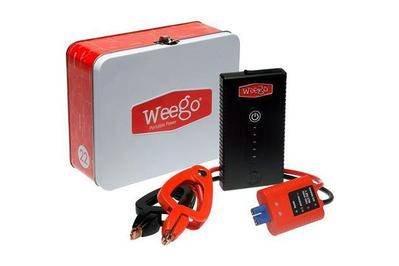
In the past, we’ve avoided recommending jump-starter battery packs because the sealed lead-acid batteries (basically a small version of your car battery) were heavy, bulky, expensive, and a pain to store and keep charged. But newer models based on lithium ion batteries are small enough to fit in a glove box, capable of holding a charge far longer, and available for less than $100. They can also recharge your phone, tablet, and other devices in a pinch.
After researching 40 portable, lithium ion jump starters and testing 12 models, we recommend the Weego Jump Starter 22s as the best jump starter for most drivers. It delivers the most impressive combination of power, safety features, build quality, and value of any model in our test group. For an accessible price, the Weego offers enough oomph to start most cars and midsize SUVs, and enough capacity to do it time after time without needing a recharge, though you should plug it in every few months to top it off. Adding one to your car can save the day when a dead battery leaves you stranded. Instead of waiting for a Good Samaritan with jumper cables or calling roadside assistance, you can use a portable jump-starter pack, which has its own high-capacity battery that attaches to your car’s battery just as normal jumper cables do.
When you start your car, the starter motor pulls a lot of power from your car battery for a short amount of time. Once the internal combustion engine turns over, it sends power back to the depleted battery via the alternator. A battery can die for a number of reasons—lights left on all night, a failing alternator, or even just regular dissipation after not driving your car for a few weeks. Aside from buying a new battery, generally you have two solutions to choose from. The first (and arguably better) option is to attach your battery to a trickle charger that will safely and slowly charge your battery back up, typically over 12 hours or more. But on the side of the road, that method won’t help you. Jump-starting your car, whether from another car or from a jump-starter pack, gives it enough juice in the first few seconds for your engine to take over and (if all goes well) charge it the rest of the way when you’re back on the road.
A portable jump starter is also easier to use than traditional jumper cables, and in case you hook it up wrong, the PowerAll unit’s safety features, such as reverse protection and audible alarms, will protect both you and your car. The clamps are sturdier than those on most other models, and they make a solid connection to a variety of battery-post shapes and sizes. The battery pack, clamps, and included wall and car chargers all fit in a handy plastic case that you can easily stow under your seat or in your trunk until you need it.—MS
 Photo: Caleigh Waldman
Photo: Caleigh Waldman 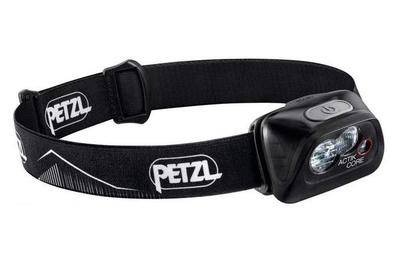
A bright light with the highest beam quality that stays charged for days—whether you charge it with a USB or AAA batteries—makes this perfect for backpacking trips.
We’ve been testing headlamps since 2012, including 40 hours of research and testing in 2019 alone. For a road trip, we like the Petzl Actik Core because it’s rechargeable—unlike our top pick, the Black Diamond Spot 325—so you won’t ever get caught with a dead battery so long as you have a USB car charger on hand. Its 450-lumen light is the brightest of all our picks. We didn’t like that it’s missing a flood feature (which is helpful for camping) and it has a lower-than-expected weatherproof rating.
Twice during our trip we pulled into our camping sites late, and our headlamp was the first thing we reached for. Knowing it was always charged meant that we didn’t have to hunt for batteries or use our car lights and disturb neighboring campers.
Right out of the box, the Petzl Actik Core was easy to use. It has just one button and three brightness options: low (6 lumens), medium (100 lumens), and high (450 lumens). If you hold down the button for several seconds, the color turns to red; double-clicking lets you access the Strobe setting. Compared with some other rechargeable headlamps, which require complicated clicking configurations to get to the desired setting, we found this one to be simpler, though we lamented its lack of a flood beam. We also liked the double-button setup of the Black Diamond Spot 325 and Vitchelo V800 a bit better than the Actik Core’s single button. —Jenni Gritters
Flare alternative
![]()
To keep yourself safe while your car is parked on the side of the road, we suggest First Alert 9.1.1 LED Emergency Beacon flare alternatives.
We like the First Alert set because for the price of one high-intensity model like the PowerFlare, you get three separate lights that are all crushproof to 20,000 pounds, waterproof, magnetic, and easy to set up and turn on. The magnets are important because they let you mount the beacons on your car, which adds height; having a flare anywhere above the surface of the road greatly increases your visibility. By putting one on the road (preferably elevated on something and located about 100 feet before your car), another on the trunk, and another on the hood, you’ll create a very visible early warning for drivers.
 Photo: Caleigh Waldman
Photo: Caleigh Waldman
The First Alert beacons (under the FlareAlert name) performed admirably in the Evaluation of Chemical and Electrical Flares, a study commissioned by the Department of Justice in 2008.
Traditional magnesium flares will almost always be brighter and more visible. But their hazards, both to your health and to the environment around you, are substantial (read the health and environmental hazards section of the above evaluation for a breakdown of the risks and the potentially harmful chemicals involved). Combine that with the fact that you can mitigate any differences in visibility simply by elevating an electric flare, and you end up with a compelling argument against using traditional flares.
By chance, we were driving behind a rental camper van that had a tire blow out on a side road in Arizona. This unexpected moment allowed us to use our emergency gear in a hurry. If you’re going to have a blowout on the road, being trailed by a car with a trunk full of emergency gear under review is a big help.
Of the three brands we tested, we couldn’t figure how to open or turn on the Wagan, and the Smittybilt U.F.O., while tough, wasn’t very effective during the day and came only one to a package. Only the First Alert beacons were easy to fill with batteries and get onto the road exactly when we needed them. They also happened to be the brightest flare alternatives we had with us.
I should take a moment here and repeat what the responding officer told us when he arrived on the scene. Regardless of what safety beacons you have laid out behind you, “stay off the road and when in doubt stay in your car.”
Multi-tool
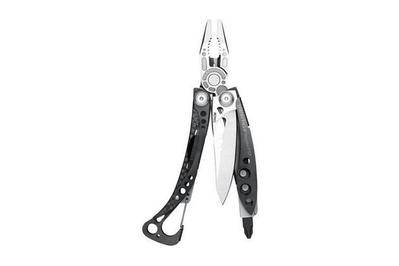
In our opinion, no emergency kit is complete without a multi-tool. They’re small enough to carry in a jeans pocket or to attach to a belt, so you can take a set of useful tools almost anywhere. Our choice is the Leatherman Skeletool CX, which comes with pliers, a bit driver, a pocket clip, and a carabiner/bottle opener, in addition to a high-quality 2.6-inch 154CM carbon-fiber stainless steel blade. The Skeletool stood out from the other 18 multi-tools we tested by focusing on the functionality, ergonomics, and solid construction of a few essential tools, instead of cramming dozens of different tools into a single bulky body that makes it difficult to use. That means it’s easy to carry, but still comes with just about everything you could possibly need to make an emergency repair in the field, on the road, or even around the house, short of a hammer and a socket set.
Water jug
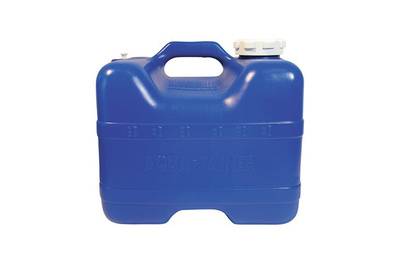
Enough water for two people for two days, with a spill-proof screw-on vent cap.
*At the time of publishing, the price was $17.
The general rule for water in an emergency is that one person needs one gallon of water for one day. Four to five gallons is a good amount to throw into your trunk—enough to get you through being stranded, even with a passenger. You should increase that estimate if you plan to go out in the middle of nowhere, or if your travels take you to a desert region or some other dry place. We found on our trip through the Southwest that we were refilling our water bottles a lot more than we were stopping for gas.
 Photo: Caleigh Waldman
Photo: Caleigh Waldman
After researching 16 different types of water jugs, we’d get the Reliance 4-Gallon Aqua-Tainer for most situations. The Reliance has two standout features: a screw-on vent cap and a spigot cap that reverses in on itself when not in use. These features work together to prevent major spills. The screw-on vent cap won’t come undone, unlike the pull-top vents on some competitors, which tend to come undone and spill as soon as you as hit anything but the smoothest roadways. Spigot caps can be a weakness for some jugs, too. When not in use, the Reliance’s spigot unscrews and drops into the jug itself, sealing up the whole canister nice and tight. We used the 4-Gallon Aqua-Tainer on our road trip, but it’s now unavailable. If you can find that, we still recommend it as a smaller option that can provide water to two people for two days. But having too much water is better than having too little, so if you can fit it, the 7-Gallon Aqua-Tainer is a safe option.
The Reliance Aqua-Tainer is made from BPA-free molded plastic, which is easy to pack around in the trunk of a car, certainly easier than large, bladder-type jugs like the MSR Dromedary Bag, which—while excellent for camp showers and easy to pack in a backpack—are simply too difficult to pack around in a car trunk because of their non-rigid shape. The Aqua-Tainer’s hard sides also make it easier to dispense from, say, the roof of your car. But be sure to throw a shirt or towel under the Aqua-Tainer before setting it atop your car like this: We learned the hard way that the molded plastic edge can scratch your paint job if you’re not careful.
Before investing in a jug, know that water in plastic bottles won’t harm you, even if left in a hot car. A 24-pack of Poland Spring is not environmentally kind, but it is safe for a brief trip. Avoid gallon jugs since they’re typically made out of HDPE plastic, which punctures easily. (Such jugs also have caps that pop off easily.) We wouldn’t buy collapsible jugs either, since they are prone to leaks and are unruly when pouring.